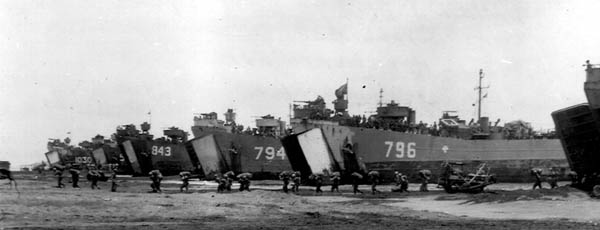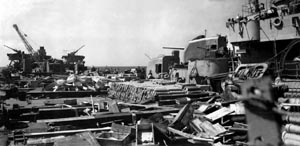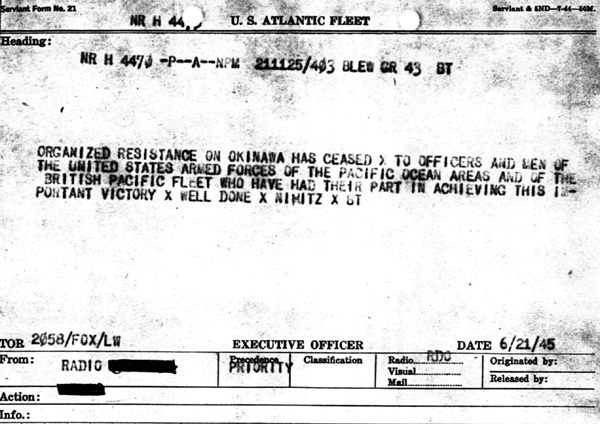LST 794 at the Invasion of Okinawa
The sequence of events described below is roughly chronological
Preparation
The invasion of Okinawa, known as Operation Iceberg, had been in the planning
stage since the fall of 1944. Okinawa was needed as an air base and
staging area for the anticipated invasion of Japan. When the '794 was
first sent to the Pacific in late 1944, she was equipped specifically for
this operation. After training with amphibious troops of the 1st Battalion,
4th Marine Regt. 6th Marine Division on Guadalcanal, she embarked with those
same troops for the staging area at Ulithi atoll. On March 25th, she
departed Ulithi, headed for Okinawa with the rest of the invasion fleet.
 Marines picnicing on
board. There wasn't seating space in the mess for everybody when the
ship had troops on board, so they ate wherever they could! There also
wasn't enough bunk space for the troops (besides, it was hot below decks
with the ship sealed up at night) so they slept wherever they could. The
main deck was largely covered by the LCT 1392, which was supported about
18 inches off the deck by large timbers, so many of the marines slept
underneath it!
Marines picnicing on
board. There wasn't seating space in the mess for everybody when the
ship had troops on board, so they ate wherever they could! There also
wasn't enough bunk space for the troops (besides, it was hot below decks
with the ship sealed up at night) so they slept wherever they could. The
main deck was largely covered by the LCT 1392, which was supported about
18 inches off the deck by large timbers, so many of the marines slept
underneath it!
L-Day
On April 1st, 1945, the '794 arrived at northern Hagushi beaches of Okinawa
and launched her troops of the 1st Battalion., 4th Marine Regt., 6th Marine
Division. First out of the hold were 13 amphibious tanks. Next
out were the Marine troops in amphibious tractors (amphtracs).
Fortunately, resistance on the beach was light and the 1st Battalion
did not meet serious enemy resistance until their second day ashore, as they
moved toward the town of Ishikawa on the Eastern coast.

Twenty four Marines head ashore in an amphtrac from the '794.
Don McKay recalls a friendly fire incident which took place on that day:
Just after dawn on April 1st, a 'kingfisher' OS2U observation plane
had been catapulted from one of the capital ships and was observing the
effectivness of the heavy bombardment on the beach when it happened to swing
over our LST task group. One of the ships started firing, and
soon others joined in,sadly down went the plane. I'm certain that our
guns did not fire. Commander Ageton who was in command of the group blasted
out over the radio "Hope you dumb bastards are satisfied, you just shot down
one of our own." Our guys were trained to wait for the order to commence
firing. So the Commander's remarks from his capital ship, did not apply to
us. Two or three minutes later we sailed right up to the spot where
the crash took place. I looked down from the conn. No sign of the tiny mustard
colored plane. No sign of the pilot. Just small bits of wreckage and an
enlarging, blue, green oil slick.
Lt. Cain (the Captain) and Ensign Goodman (Gunnery officer) obviously trained
the '794 gun crews well. They did not panic and kept their fingers
off the triggers without a clear order to fire.
 A view of the
invasion beachead as seen from the ship. The '794 was part of Task
Group 53.3, the Northern Tractor Flotilla, and landed her troops on GREEN
BEACH.
A view of the
invasion beachead as seen from the ship. The '794 was part of Task
Group 53.3, the Northern Tractor Flotilla, and landed her troops on GREEN
BEACH.
According to Morison (History of the United States Navy in World War
II; Victory in the Pacific 1945, Vol. XIV, p173)
"LST's of Captain J.S. Laidlaw's Northern Tractor Flotilla were overloaded
with cargo, amphtracs, land tanks, dukws, wheeled vehicles, engineer equipment
and naval ammunition. Twenty-nine LST's carried pontoon barges or causeway
sets secured alongside, 16 carried LCT's on their decks (note: the 794 carried
BOTH!), and none of these could be unloaded promptly; vehicles stowed in
an LCT, and naval ammunition stowed under them, had to be removed before
the landing craft could be launched. LST stowage in this operation
was something like those Chinese nests of boxes which must be unpacked in
order, or not at all.
Although each LST in the transport area discharged her men and amphtracs
in time to land on schedule, the LST's themselves were delayed coming into
the northern beaches until L-day plus 1, when eleven slots were ready for
them on Beaches Blue 1 and Yellow 2. Unloading continued all night
from 2 April on, with the aid of lights."
According to the ship's log, after launching her Marines at 7:00 am, the
ship moved several times during the day, and stood into the beach at 12:38
in the afternoon. That evening, the '794 was anchored one mile
off of GREEN BEACH TWO and unloaded ammunition until there were no more vehicles
available to carry it - around 9 pm. Watches were set overnight on
the bow doors and the port and starboard pontoons to guard against possible
underwater demolition.
The photo below shows LST 794 on the beach at Okinawa, together with LST
796, LST 843, and LST 1030. This photo was taken in July 1945, after
the island was secured.

Photo courtesy of Daniel Dobey, U.S.C.G., LST
796
 The next
day, the LCT 1392 was launched from the main deck. (Read
"How to launch an
LCT"). The pontoon bridging units that the ship had carried all
the way from the States were also launched. The crew spent the
next six days unloading priority cargo for the troops ashore. This
photo shows the LCT being readied for launching.
The next
day, the LCT 1392 was launched from the main deck. (Read
"How to launch an
LCT"). The pontoon bridging units that the ship had carried all
the way from the States were also launched. The crew spent the
next six days unloading priority cargo for the troops ashore. This
photo shows the LCT being readied for launching.
For the invasion of Okinawa, the '794 was loaded
with 5 inch ammunition, which was stored in shipping tubes on the tank deck.
The ammo was then covered over with miscellaneous building
lumber. Amphibious vehicles were driven in and parked on top of the
stacked "floor" of ammunition. Good thing they didn't get hit! On
the morning of April 3, the '794 offloaded her ammunition to the destroyer
Heywood L. Edwards, DD-663, one of the antiaircraft picket ships that
protected the landing areas. As you can see from the photos below,
the offloading was a major operation! The broken crates on the LST's
deck are ammo crates that were taken aboard from the Heywood L. Edwards
for storage and disposal.
As usual - Click to enlarge!
(Thanks to William Hooper for making this composite
image!)

As the first line of defense against incoming Kamikaze planes, the picket
ships took a tremendous beating. Overall, in the Okinawa campaign,
30 Naval ships were sunk, mostly by Kamikaze attacks, and 368 were damaged.
Over 49,000 sailors were killed or missing and 4824 were wounded.
The Heywood L. Edwards survived this campaign and the war. In
1959 she was loaned to the Japanese Navy!
where she served as the Ariake.
You
can read the history of the Heywood L. Edwards Here
 Some of
the crew out on one of the landing craft at Okinawa. On April 4, three
days after the landing, one of the ship's two small boats (LCVP), moored
alongside, was swamped and sunk during a "moderate gale."
Some of
the crew out on one of the landing craft at Okinawa. On April 4, three
days after the landing, one of the ship's two small boats (LCVP), moored
alongside, was swamped and sunk during a "moderate gale."
Kamikaze Attacks: Operation
Ten-Go
The Japanese plan for defending Okinawa called for massive Kamikaze attacks
to destroy the U.S. Naval forces. The Kamikaze plan, Operation Ten-Go,
commenced on April sixth with assaults by 699 Japanese aircraft. 355
of them were Kamikazes.
On the April sixth, the flotilla was attacked several
times by Kamikazes. In one incident, three planes were shot down about
two miles from the ship. In the second incident, one plane came in
very close. With every ship in the area firing, the attack was defeated.
The plane crashed into the water between the '794 and the ship to
starboard. On impact, the propeller popped off and landed on the aft
deck of the neighboring ship. During this attack, four of the crew (Felix
Mangin, Marcus Holmes, Arnold Lucas, and Charles Murphy) were wounded
by 20mm shell fragments fired from from neighboring ships! They later
recieved Purple Heart medals.
April 7th, another attack. On the '794, Raymond
H. Charitat of the Navy 58th construction battalion was injured in the head
by flying shrapnel.
Ashore
The following pictures of Japanese aircraft were taken at Yonton airfield
on Okinawa.
 A Japanese plane,
destroyed under its camoflauge netting. U.S. troops in the
background. This is plane is a Kawasaki-61 Interceptor, code named
Tony, belonging to the 23rd Independent Co.
A Japanese plane,
destroyed under its camoflauge netting. U.S. troops in the
background. This is plane is a Kawasaki-61 Interceptor, code named
Tony, belonging to the 23rd Independent Co.
(Thanks to Aaron Parsons and Bill Lawson for the identification).
 A
Nakajima
Army Fighter Type 1 Ki-43 "Hayabusa, " which the U.S. code named
Oscar, being inspected by U.S. personnel.
A
Nakajima
Army Fighter Type 1 Ki-43 "Hayabusa, " which the U.S. code named
Oscar, being inspected by U.S. personnel.
(Thanks to Hervé Pigeon for correcting the identification)
Departure for Resupply
On April 11, the '794 left Okinawa for the Saipan to load reinforcements
and supplies. By May 14, the ship was back at Okinawa unloading
once again. On May 20, 1945 the LST 794 left Okinawa for other assignments
in the Phillipines.
Okinawa is Taken
For over two months, the Marines on Okinawa faced some of the bloodiest fighting
of the war, but finally, on June 21, the island was declared taken:

The ship returned to Okinawa late in September and had to leave the Hagushi
anchorage in early October to avoid a severe typhoon. They weathered
it at sea. Read all about it
Here.
Return to the LST 794 Homepage
 Marines picnicing on
board. There wasn't seating space in the mess for everybody when the
ship had troops on board, so they ate wherever they could! There also
wasn't enough bunk space for the troops (besides, it was hot below decks
with the ship sealed up at night) so they slept wherever they could. The
main deck was largely covered by the LCT 1392, which was supported about
18 inches off the deck by large timbers, so many of the marines slept
underneath it!
Marines picnicing on
board. There wasn't seating space in the mess for everybody when the
ship had troops on board, so they ate wherever they could! There also
wasn't enough bunk space for the troops (besides, it was hot below decks
with the ship sealed up at night) so they slept wherever they could. The
main deck was largely covered by the LCT 1392, which was supported about
18 inches off the deck by large timbers, so many of the marines slept
underneath it!








